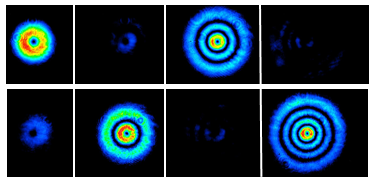Into the radial modes of light
09.03.2018
Light can have very complex and aesthetically pleasing structures. One prominent example is the so-called Laguerre-Gauss (LG) family, which is described by two physical degrees of freedom. The angular momentum of light is one of them and has already been intensively studied. The second, much less investigated degree of freedom is the radial structure of light. This degree of freedom is characterized by its ring-shaped structure and, depending on the number of rings, can in principle carry an infinite amount of information. Thus, if the individual rings can be separated, much more information can be transmitted.
In the just published article in Physical Review Letters, Xuemei Gu and her colleagues in the group of Anton Zeilinger at IQOQI and University of Vienna, show how to sort ring modes [1]. The method is based on an interferometer with one input and two outputs. Depending on the number of rings, these modes are routed to the two different outputs. For example, even and odd number of rings can be distinguished.
The trick here is to achieve a ring-number dependent phase. The physical realization was found with the help of the computer algorithm Melvin [2]. The scientists use a geometric phase that accumulates during propagation through lens systems. This so-called Gouy phase can be chosen with a specific arrangement of lenses such that, for example, for an even number of rings, constructive interference and for odd numbers of rings, destructive interference occurs. Combining several such interferometers would allow for access to a very large number of ring-modes.
The new method now allows access to the complete spatial structure of light. The Viennese researchers expect applications of their new technology in classical communication protocols (multiplexing) as well as in the quantum domain. A possible application in the field of quantum physics is the teleportation of individual photons. In future, this new technology could help achieving a long standing goal, namely the teleportation of the entire spatial state of a single photon.
[1] Xuemei Gu, Mario Krenn, Manuel Erhard, and Anton Zeilinger, Gouy Phase Radial Mode Sorter for Light: Concepts and Experiments, Phys. Rev. Lett.120, 103601 (2018).
[2] Mario Krenn, Mehul Malik, Robert Fickler, Radek Lapkiewicz, and Anton Zeilinger, Automated Search for new Quantum Experiments, Phys. Rev. Lett.116, 090405 (2016).
Original Publication:
Xuemei Gu, Mario Krenn, Manuel Erhard, and Anton Zeilinger, Gouy Phase Radial Mode Sorter for Light: Concepts and Experiments, Phys. Rev. Lett.120, 103601 (2018).
DOI:
https://doi.org/10.1103/PhysRevLett.120.103601
